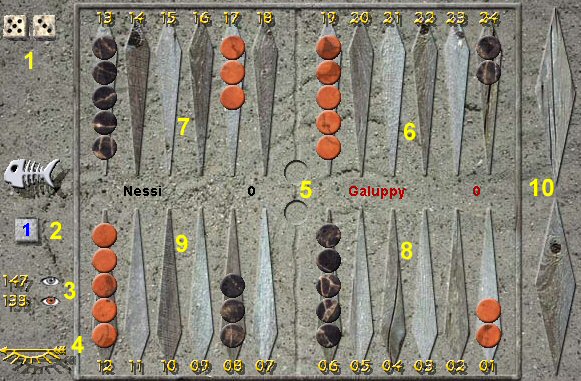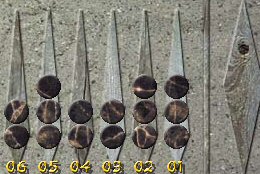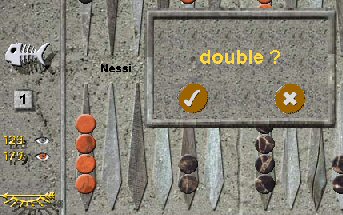Backgammon
Backgammon (Originalregel)
Préparation du Jeu
2 joueurs peuvent participer à une partie en valant /join Démarrez le jeu avec /start Il est aussi possible d'utiliser les raccourcis de l'outil Jeu.
Le jeu
Chaque joueur doit lancer les dés pour déplacer ses 15 pions ; il faut les rassembler dans le Jan intérieur puis les sortir. Le premier à le faire gagne le jeu.
Plateau de jeu

- Dés
- Dé multiplicateur (utilisé uniquement avec l'option Match)
- Points
- Flèche retour (pour sortir)
- Barre ("Bar")
- Jan intérieur de Rouge (19-24)
- Jan extérieur de Rouge (13-18)
- Jan intérieur de Noir (01-06)
- Jan extérieur de Noir (07-12)
- Emplacement of the pions sortis
Le plateau de jeu est séparé en quatre domaines (6 à 9) : séparés horizontalement entre les pointes et verticalement par la barre. L'image montre la position de départ des pions.
Noir et Rouge déplacent leurs pions sur le plateau dans des sens opposés :
- Rouge se déplace dans le sens horaire, ainsi les pions byt de la flèche 01 vers la flèche 24.
- Noir se déplace dans le sens anti-horaire, ainsi les pions byt de la flèche 24 vers la flèche 01.
Déroulement du jeu
Les joueurs alternativement lancent les dés et déplacent leurs dans leurs directions associates. Le but dans un premier temps est de rassembler tous ses pions dans son Jan intérieur. Une fois que c'est fait, on peut faire sortir ses pions.
L'oeil du poisson indique toujours la couleur du joueur actif. Il doit lancer les dés en cliquant sur les dés en haut à gauche.
Les pions ne peuvent être déplacés que dans le sens précédemment décrit, jamais dans le sens opposé. Un joueur peut utiliser la valeur des dés de différentes manières. Il peut
a) déplacer deux pions, chacun de la valeur d'un des deux dés
ou
(b) déplacer un pion de la valeur d'un dé puis le même pion de la valeur du deuxième dé.
Il n'est pas permis de déplacer un pion directement de la somme des deux dés.
Example : joueur lance 6 et 3. Il peut alors
a) déplacer un pion de six flèches et un autre de trois
ou
b) déplacer un pion de six flèches puis encore de trois (ou d'abord de trois puis six)
On peut placer autant de pions que l'on veut de la même couleur sur une flèche.
Double
Si un joueur obtient un double (deux dés de même valeur), il peut utiliser son lancer deux fois. Toutes les combinaisons imaginables sont permises.
Example : un joueur lance un double 5. Il peut soit
déplacer quatre fois un pion de 5 cases
ou
déplacer trois fois un pion de 5 cases et un autre de 5 cases
ou
déplacer deux pions de deux fois 5 cases chacun
ou
deplacer 4 pions chacun de 5 cases
Utiliser les deux dés
Un joueur a souvent plusieurs possibilités pour déplacer ses pions. Il doit dans ce cas toujours faire ses déplacements de façon à utiliser les deux dés.
Example : le lancer est 6 et 2.
Le joueur peut utiliser le 2 de différentes façons, mais pour certaines le 6 ne peut plus être utilisé. Le joueur doit choisir une possibilité qui lui permette d'utiliser le 6.
Aucun déplacement possible

Si un joueur ne peut utiliser aucune valeur des dés lancés, il perd les deux et l'adversaire reprend la main. Le joueur doit cliquer sur le pion barré sous les dés pour passer son tour.
Déplacements pas tous possibles
Si un joueur ne peut pas utiliser une valeur de dé, celui ci est perdu. Si toutes les valeurs d'un double ne sont pas utilisables, les déplacementss doivent être faits, le reste est perdu. Les flèches qui sont occupées par plus d'un pion adverse, ne peuvent être occupées.
Frapper und pion
Une flèche, qui n'est occupée que par un seul pion, est appelée "blot".
Si un joueur déplace un pion sur un blot de l'adversaire, celui-ci est "frappé" et est immédiatement posé sur le "bar" (la zone centrale). Il n'y a pas de contrainte de coup ; s'il y a un autre mouvement, le joueur peut se décider en faveur de l'autre mouvement.
Remise en jeu d'un pion
Si le joueur à qui c'est le tour a un pion sur le "bar", celui-ci doit d'abord être "rentré" sur la table avant de pouvoir déplacer un autre pion. Les pions sur le "bar" doivent toujours être joués dans le camp intérieur de l'adversaire : pour Noir sur les flèches 1 à 6 et pour Rouge sur les flèches 24 à 19. Pour la remise en jeu, le déplacement est compté comme si le pion était à l'extérieur de la table.
Si l'on n'a qu'un seul pion sur le "bar" et que l'on peut le rentrer avec un dé de son lancer, on peut utiliser le deuxième dé pour déplacer un autre pion. Si l'on a encore d'autres pions sur le "bar", on dot d'abord les remettre en jeu. Si cela n'est pas possible car les flèches sont occupées par l'adversaire, on perd son lancer et c'est au tour de l'adversaire de jouer. Les pions en jeu ne peuvent être déplacés uniquement lorsque aucun pion ne reste sur le "bar".

Rouge a lancé 4 et 1. Comme les deux flèches sont occupées par Noir, Rouge doit passer son tour. Si Noir avait des pions sur le "Bar", il pourrait rentr sur 1 ou 5.
Les "blots" peuvent être aussi frappés sur remise en jeu d'un pion.

Si un joueur a bloqué les 6 flèches de son camp, cela est considéré comme un blocage (shut-out). Dans ce cas aucun pion sur le "bar" ne peut être rentré. Le joueur avec le shut-out joue seul jusqu'à ce qu'il soit contraint d'ouvrir une flèche (en laissant 0 ou 1 pion). L'adversaire écarté doit passer pendant ce temps.
Sortir
Lorsqu'un joueur a réussi à rassembler ses 15 pions dans son camp, il peutstartr à les "sortir" de la table de jeu. Sortir n'est possible que si aucun pion ne se trouve ni à l'extérieur du jan Internal, ni sur le bar. Un pion, qui est sorti, ne revient plus sur la table. Pour sortir, il faut compter comme s'il fallait atteindre la première flèche à l'extérieur de la table de jeu.
Example : Noir a des pions sur chacune de ses flèches de son jan intérieur. Il lance 5 et 3. Il peut sortir un pion de la flèche 5 et de la flèche 3.

Si un joueur obtient au dé une valeur qui est supérieure à la flèche la plus éloignée contenant un pion, il peut retirer un pion de cette flèche.
Example : Noir a déjà vidé les flèches 5 et 6. S'il obtient un 5 ou un 6, il peut sortir un pion de la flèche 4.
Fin de la partie
Le jeu se termine dès que le premier joueur a pu sortir tous ses pions. Le score est comptabilisé, en fonction des points dont l'adversaire aurait encore eu besoin pour sortir tous ses pions. (PIP-Count)
Options
match
Cette option permet de fixer le nombre de points pour gagner la partie ; c.-à.-d. on joue des jeux jusqu'à ce qu'un joueur atteigne ou dépasse le nombre de points fixé. Le PIP-Count n'a aucune influence pour ce mode.
L'option match utilise le dé doubleur (videau). Une victoire compte normalment un point. En utilisant le dé doubleur avant de lancer les dés, le joueur à qui c'est le tour peut proposer de doubler la valeur de la Manche.

Pour cela, il clique simplement sur le dé doubleur au-dessous du poisson. Chez l'adversaire, la fenêtre ci-contre apparaît, dans laquelle il peut choisir s'il accepte le doublement ou non. S'il accepte, la valeur de la some est doublée ; s'il refuse, il perd la some avec la valeur courante de la some.
Example : un joueur choisit de doubler pour la première fois ; si l'adversaire refuse, il perd le jeu avec un point de some. S'il accepte, le jeu se poursuit et le vainqueur recevra deux points de match pour la victoire (si la some n'est pas doublée à nouveau).
Le doublement doit toujours être proposé alternativement ; c.-à.-d. si Noir a doublé, la prochaine proposition de doublement ne peut venir que de Rouge. Un joueur ne peut pas proposer de doubler deux fois de suite.
gammon
Si un joueur a sorti tous ses pions, avant que son adversaire ait pu sortir un seul de ses pions, cela s'appelle gammon et le vainqueur reçoit pour cela le double des points de some.
Backgammon
Si un joueur a sorti tous ses pions, avant que son adversaire ait pu sortir un seul de ses pions et que celui ci a encore au moins un pion dans le Jan intérieur de son adversaire ou sur le "Bar", cela s'appelle Backgammon et le vainqueur reçoit pour cela le triple des points de some.
Règle Crawford
La règle Crawford spécifie que le dé doubleur ne peut pas être utilisé si l'un des joueurs est arrivé à un point de la victoire (par ex. 6 points dans un Match 7). Cette règle ne s'applique que pour la some suivant l'obtention du score (match -1). Dans les Manches suivantes, le dé doubleur peut être utilisé normalment.
L'option match peut aussi être utilisée sans valeur numérique en tapant la commande /option match basic. On joue alors avec le dé doubleur sans fixer de score de victoire. A la fin d'une some, les deux joueurs reçoivent alors une fenêtre dans laquelle il leur est demandé s'ils veulent continuer (continue?) ou arêter la partie (X).
tutor
L'option tuteur fait apparaître la numérotation des flèches pour faciliter les explications.

